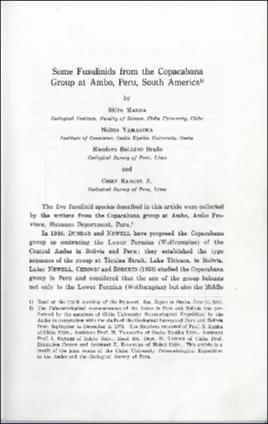- Repositorio Institucional INGEMMET
- Ponencias y Artículos científicos
- Ponencias, comunicaciones en congresos
Please use this identifier to cite or link to this item:
https://hdl.handle.net/20.500.12544/2504Some fusulinids from the Copacabana Group at Ambo, Peru, South America
1974
Palaeontological study on the Andes, 1974, pp. 1-13
[ENG] The five fusulinid species described in this article were collected by the writers from the Copacabana group at Ambo, Ambo Province, Huanuco Department, Peru. In 1946, Dunbar and Newell have proposed the Copacabana group as embracing the Lower Permian (Wolfcampian) of the Central Andes in Bolivia and Peru; they established the type sequence of the group at Tiquina Strait, Lake Titicaca, in Bolivia. Later Newell, Chronic and Roberts (1953) studied the Copacabana group in Peru and considered that the age of the group belongs not only to the Lower Permian (Wolfcampian) but also the Middle Permian (Early Leonardian) by their Palaeontological study. According to them, this group mainly consists of black bituminous shales and massive limestones with subordinate dolomites, siltstones and fine sandstones. At many places, the Copacabana group may rest disconformably on older rocks. The group is overlain by the Middle Permian (Late Leonardian or Post Leonardian) Mitu group unconformably in many areas. A fusulinid species such as Triticites sp. has been described by Newell, Chronic and Roberts (1953) from the Copacabana group at Ambo, Peru. According to them, it is very similar to Triticites secalicus from the Upper Pennsylvanian in United States. Therefore, they considered that the Copacabana group at Ambo might be equivalent to the Upper Pennsylvanian in United States. In this study, the following fusulinid species are found from the same locality that reported by Newell, Chronic & Roberts (1953) at Ambo.
[SPA] Las cinco especies de fusulínidos descritas en este artículo fueron recolectadas por los investigadores del grupo Copacabana en Ambo, provincia de Ambo, departamento de Huánuco, Perú. En 1946, Dunbar y Newell propusieron que el grupo Copacabana abarcara el Pérmico Inferior (Wolfcampian) de los Andes Centrales en Bolivia y Perú; establecieron la secuencia de tipos del grupo en el Estrecho de Tiquina, Lago Titicaca, en Bolivia. Posteriormente Newell, Chronic y Roberts (1953) estudiaron el grupo Copacabana en el Perú y consideraron que la edad del grupo pertenece no sólo al Pérmico Inferior (Wolfcampian) sino también al Pérmico Medio (Early Leonardian) por su estudio Paleontológico. Según ellos, este grupo consiste principalmente en pizarras bituminosas negras y calizas masivas con dolomitas, limolitas y areniscas finas subordinadas. En muchos lugares, el grupo de Copacabana puede descansar de manera inconforme sobre rocas más antiguas. El grupo está superpuesto por el grupo Mitu del Pérmico Medio (Late Leonardian or Post Leonardian) de manera inconforme en muchas áreas. Una especie de fusulínido como Triticites sp. ha sido descrita por Newell, Chronic y Roberts (1953) del grupo Copacabana en Ambo, Perú. Según ellos, es muy similar a Triticites secalicus del Upper Pennsylvanian en los Estados Unidos. Por lo tanto, consideraron que el grupo Copacabana en Ambo podría ser equivalente al Upper Pennsylvanian en los Estados Unidos. En este estudio, se encuentran las siguientes especies de fusulínidos de la misma localidad que la reportada por Newell, Chronic & Roberts (1953) en Ambo.
[SPA] Las cinco especies de fusulínidos descritas en este artículo fueron recolectadas por los investigadores del grupo Copacabana en Ambo, provincia de Ambo, departamento de Huánuco, Perú. En 1946, Dunbar y Newell propusieron que el grupo Copacabana abarcara el Pérmico Inferior (Wolfcampian) de los Andes Centrales en Bolivia y Perú; establecieron la secuencia de tipos del grupo en el Estrecho de Tiquina, Lago Titicaca, en Bolivia. Posteriormente Newell, Chronic y Roberts (1953) estudiaron el grupo Copacabana en el Perú y consideraron que la edad del grupo pertenece no sólo al Pérmico Inferior (Wolfcampian) sino también al Pérmico Medio (Early Leonardian) por su estudio Paleontológico. Según ellos, este grupo consiste principalmente en pizarras bituminosas negras y calizas masivas con dolomitas, limolitas y areniscas finas subordinadas. En muchos lugares, el grupo de Copacabana puede descansar de manera inconforme sobre rocas más antiguas. El grupo está superpuesto por el grupo Mitu del Pérmico Medio (Late Leonardian or Post Leonardian) de manera inconforme en muchas áreas. Una especie de fusulínido como Triticites sp. ha sido descrita por Newell, Chronic y Roberts (1953) del grupo Copacabana en Ambo, Perú. Según ellos, es muy similar a Triticites secalicus del Upper Pennsylvanian en los Estados Unidos. Por lo tanto, consideraron que el grupo Copacabana en Ambo podría ser equivalente al Upper Pennsylvanian en los Estados Unidos. En este estudio, se encuentran las siguientes especies de fusulínidos de la misma localidad que la reportada por Newell, Chronic & Roberts (1953) en Ambo.
Geology Laboratory, faculty of Science, Chiba University
Maeda, S.; Yamagiwa, N.; Bellido, E. & Rangel, C. (1974). Some fusulinids from the Copacabana Group at Ambo, Peru, South America. In: Palaeontological study on the Andes. Geol. Labor., Fac. Sci., Chiba Univ., pp. 1-13.
Artículo leído en la Reunión 113 del Palaeontological Society of Japan, en Osaka, 15 de junio de 1974. | El reconocimiento paleontológico de los Andes en Perú y Bolivia fue realizado por los miembros de la Expedición Paleontológica a los Andes de la Universidad de Chiba en cooperación con el personal de los Servicios Geológicos de Perú y Bolivia de septiembre a diciembre de 1973.
Files in This Item:
| File | Description | Size | Format | |
|---|---|---|---|---|
| Maeda-Some_fusulinids_Copacabana_Group.pdf | Artículo en congreso | 6.74 MB | Adobe PDF | View/Open |
This item is licensed under a Creative Commons License












